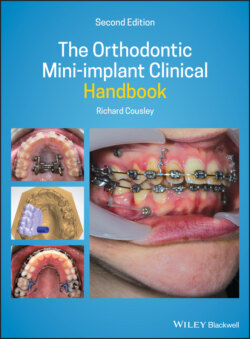Читать книгу The Orthodontic Mini-implant Clinical Handbook - Richard Cousley - Страница 46
3.3 Digital Stent Fabrication Processes
ОглавлениеThe manual stent process, described above, has worked well in the last 10 years, but it does involve the process of mentally merging the topographical (model surface) and 2D radiographic information. In the coming years, this process will be superseded by the introduction of digital model technology. For example, it is now possible to produce stents for palatal and alveolar insertion sites using digital CAD‐CAM software (Figures 3.11 and 3.12). This enables orthodontists already using virtual orthodontic models to produce a physical stent, using a 3D printed model and the (manual) Infinitas guidance kit. However, whilst digital models provide accurate (tooth and soft tissue) topographical information, they can only offer hints of the underlying root positions. They cannot give us a direct view of what lies below the surface – the skeletal (e.g. cortex and cancellous bone depth and distance to adjacent structures) and dental anatomy in the sites where the mini‐implant body will be positioned. These require the additional input of CBCT data for comprehensive 3D planning.
It is becoming feasible to accurately plan mini‐implant positions in 3D by merging digital models and CBCT data together [51]. This will unite their topographical and bone/root positional information, and promises to improve the accuracy of insertions. For example, a 2013 study demonstrated that the use of guidance stents produced from CBCT and digital model data resulted in the avoidance of adjacent tooth roots in 84% of insertions compared with 50% in a control group [52]. At the time of writing this edition, customised software specifically designed for orthodontic mini‐implant guidance purposes is being more widely developed (Figure 3.13). Therefore, established orthodontic planning packages are likely to incorporate this facility in due course. These will probably feature the ability to computer‐design and export a virtual stent for direct 3D printing, without the need to print a working model as an intermediary step. However, those orthodontists who still prefer to have a tactile planning process will be able to 3D print a working model from digital files and then manually drill a pilot hole in a physical model.
Figure 3.11 Diagram of a (green) computer‐generated guidance stent, with twin midpalatal cylinders, superimposed on a (red) digital model of the maxillary arch.
Figure 3.12 (a,b) Illustrations of a unilateral palatal stent designed using ‘Appliance Designer’ software (www.3shape.com/en/software/ortho‐system). The baseplate, shown in light blue, was sculpted on the digital model of the maxillary dentition. The guidance cylinder (dark blue) was added and orientated in 3D prior to 3D printing a plastic stent in a biocompatible material. The resultant mini‐implant position is shown in (c) immediately after insertion using the stent.
Figure 3.13 (a–c) Diagrams of a CBCT software package being used to plan placement of a (green) virtual mini‐implant mesial/buccal to the right maxillary first molar, in the three different sectional views plus in a 3D reformatted view. A virtual abutment (shown in red) can be attached to the CBCT mini‐implant. This accentuates the 3D angles of insertion. (d) This information is then used to fabricate a virtual guidance stent, produced by 3D printing. (www.dolphinimaging.com).
Source: The images in (d) were kindly produced using Dolphin® software by Dr Paul Thomas, Scientific Advisor, Dolphin Imaging & Management Solutions
